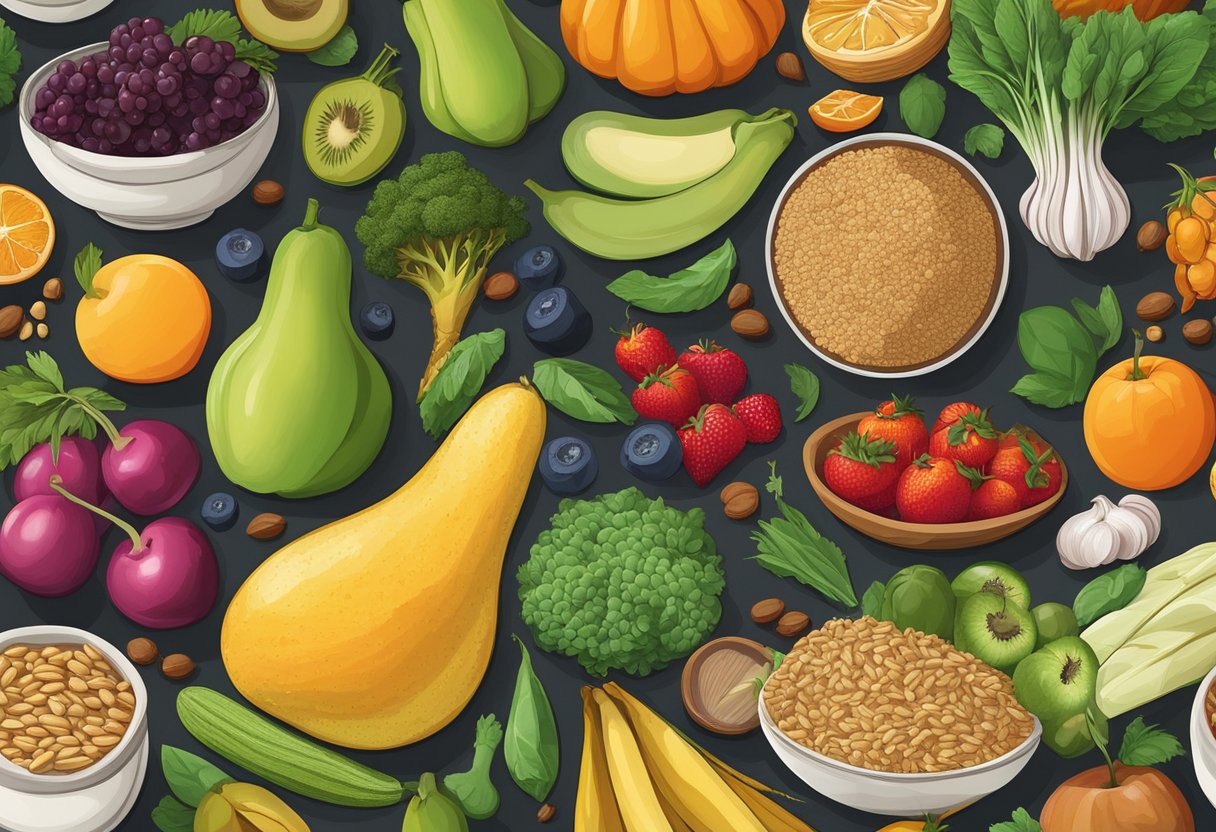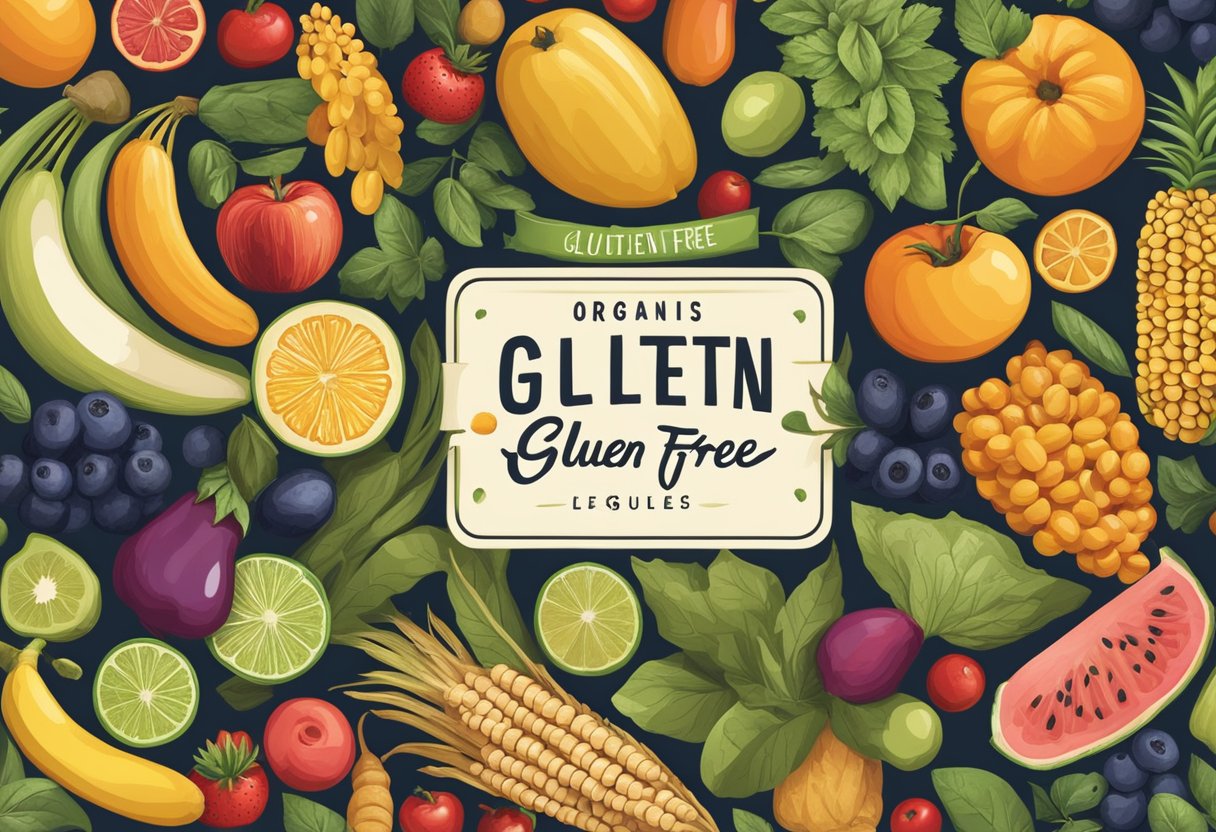Adopting a gluten-free diet is a necessity for those with celiac disease and a preference for others seeking a healthier lifestyle. The Mediterranean diet, renowned for its health benefits, primarily consists of fruits, vegetables, legumes, nuts, and lean proteins like fish, offering a naturally gluten-free framework. Organic and Non-GMO iterations of this diet further enhance its appeal, providing individuals with additional assurances about the quality and origins of their food, and can contribute positively to both personal health and global environmental sustainability.

Combining the principles of a gluten-free diet with the Mediterranean approach introduces a variety of foods that are both nourishing and naturally devoid of gluten. This synergy not only caters to the dietary needs of those with gluten sensitivities but also aligns with a global shift towards conscientious eating patterns.
As individuals strive for a balanced diet, the selection of organic and Non-GMO foods becomes integral in ensuring that the meals are as pure and nutrient-rich as possible—free from genetically modified organisms and grown without synthetic pesticides or fertilizers.
Key Takeaways
- A gluten-free Mediterranean diet emphasizes natural, unprocessed foods that support health and well-being.
- Prioritizing organic and Non-GMO ingredients ensures meals are made with high-quality produce and proteins.
- Following this diet necessitates careful selection of gluten-free alternatives, balanced meal planning, and strategic grocery shopping.
Table of Contents
Understanding the Gluten-Free Mediterranean Diet

The Gluten-Free Mediterranean Diet combines the heart-healthy principles of the traditional Mediterranean lifestyle with a diet free from gluten. This fusion ensures that individuals with celiac disease or gluten sensitivity can enjoy the benefits of Mediterranean eating without the adverse effects of gluten.
Basics of the Mediterranean Diet
The Mediterranean Diet primarily emphasizes plant-based foods, such as vegetables, fruits, nuts, legumes, and whole grains. Olive oil is the main source of added healthy fats, and a moderate amount of protein is sourced from poultry, fish, and dairy products. Red meat’s presence is scarce, and processed foods are minimal. The following table breaks down the basic food groups included in the Mediterranean diet:
| Food Group | Examples |
|---|---|
| Vegetables | Tomatoes, asparagus, spinach |
| Fruits | Apples, figs, avocado |
| Nuts | Almonds, walnuts |
| Legumes | Chickpeas, lentils |
| Grains | Whole grain pasta, brown rice |
| Proteins | Poultry, salmon, eggs |
| Dairy | Yogurt, cheese |
| Fats | Olive oil, olives |
Core Components of a Gluten-Free Diet
A gluten-free diet necessitates the avoidance of gluten, a protein composite found in wheat, barley, rye, and their derivatives. For those with celiac disease or gluten sensitivity, it is vital to eliminate foods containing gluten to prevent health complications. Here are essential gluten-free alternatives:
- Grains: Rice, buckwheat, quinoa, corn, and gluten-free oats
- Proteins: All unprocessed meats, fish, and eggs
- Legumes: Beans, soy products, and lentils
- Dairy: Most dairy products are naturally gluten-free; be cautious with flavored yogurts and processed cheese.
Merging the Mediterranean and Gluten-Free Diets
Merging the benefits of the Mediterranean diet with a gluten-free lifestyle involves careful selection of ingredients. Quinoa and brown rice can replace grains like bulgur or couscous. Unprocessed proteins, such as fish, poultry, and eggs, are suitable for both diets, offering vital nutrients and healthy fats. When considering dairy, one must select options like natural yogurt and aged cheeses that are less likely to contain additives or gluten-based thickeners. Legumes like chickpeas and beans not only serve as great protein sources but are integral to a gluten-free Mediterranean diet.
Gluten-free adaptations also mean avoiding gluten-containing sauces and ensuring that any processed foods are certified gluten-free. Olive oil remains a cornerstone as a healthy fat, while non-traditional gluten-free products, like those from Green Chef, can facilitate meal planning. The careful inclusion of vegetables and fruits in every meal packs a wealth of nutrients and antioxidants in line with Mediterranean traditions.
Organic and Non-GMO Food Choices
Incorporating organic and Non-GMO options into a gluten-free Mediterranean diet can enhance the diet’s natural and health-focused ethos. This section will focus on what “organic” really means and the distinct advantages of Non-GMO products.
Understanding Organic Foods
When exploring the gluten-free Mediterranean diet, organic produce and ingredients play a crucial role. Organic refers to the way agricultural products are grown and processed, adhering to strict guidelines set by the United States Department of Agriculture (USDA). A product labeled as “USDA certified organic” ensures that at least 95% of the ingredients are organic, meaning they are free from synthetic additives like pesticides and chemical fertilizers, and have not been processed using industrial solvents, irradiation, or genetic engineering. However, there are variations within the organic label; for instance, “100% organic” means every ingredient and processing aid is organic. Another tier, “made with organic,” signifies that a minimum of 70% of ingredients are organic, with some restrictions on the remaining 30%.
- USDA certified organic company: These businesses comply fully with USDA standards across the board—from production to processing and labeling.
- Sustainability: Organi**c farming practices are designed to promote environmental health, sustainability, and the conservation of biodiversity.
- USDA and sustainable ingredients: When consumers purchase products with the USDA organic seal, they are supporting a food system that is committed to sustainable practices.
Benefits of Non-GMO Products
Non-GMO products are those that are not genetically modified and thus do not contain genetically modified organisms (GMOs). The gluten-free Mediterranean diet benefits from Non-GMO products because they use whole ingredients that are in their natural state and have not been altered at a genetic level. This aligns with the diet’s emphasis on natural foods and health benefits.
- Avoidance of GMOs: Selecting Non-GMO foods works in tandem with organic choices, as certified organic foods are also inherently non-GMO. Opting for Non-GMO foods means avoiding genetic engineering in the production process.
- USDA certified organic labeling: These products ensure consumers that the items meet stringent organic and Non-GMO requirements, fostering trust and transparency in the food system.
Healthy Eating Patterns

The Healthy Eating Patterns section focuses on implementing diversity in food choices and managing portion sizes and meal schedules, particularly with a gluten-free Mediterranean approach.
Incorporating Variety into Meals
Incorporating a variety of foods into meals is crucial for a balanced gluten-free Mediterranean diet. Individuals should focus on consuming a range of whole foods, such as vegetables, fruits, legumes, and lean proteins like fish and poultry. Whole grains are also an important component; options like quinoa and buckwheat are gluten-free and can be used in place of traditional grains. Including chickpeas and other legumes not only provides protein but also adds fiber and nutrients that are key for overall health and weight loss.
Portion Control and Meal Timing
Portion control plays a pivotal role in a gluten-free Mediterranean diet, helping to regulate calorie intake without sacrificing nutrition. For convenience, individuals may opt for meal kits or meal delivery services that cater to gluten-free and calorie smart needs. These services ensure portion control and can be particularly advantageous for those with busy schedules or food allergies. Adhering to a schedule that spaces meals and snacks evenly throughout the day can assist in maintaining energy levels and managing hunger, aligning with meal plans aimed at sustained weight loss or management. When it comes to carbohydrates in a gluten-free diet, choosing low-carb options or prepared meals high in vegetables and lean proteins can contribute to a nutrient-rich diet without compromising on taste or satisfaction.
Selecting Gluten-Free Alternatives
In adapting a gluten-free Mediterranean diet, one must carefully select alternative grains and proteins that align with the diet’s principles. These alternatives should not only exclude gluten-containing grains like wheat, barley, and rye but also provide similar nutritional values.

Grains and Pasta Alternatives
For those on a gluten-free Mediterranean diet, grains such as quinoa and rice serve as excellent substitutes for traditional gluten-containing grains. Quinoa, a complete protein with all nine essential amino acids, is also a good source of fiber and iron. Pasta lovers can find suitable alternatives made from corn, rice, or legumes, which offer a similar texture to wheat pasta:
- Corn pasta: A good option for those who appreciate a firmer texture.
- Rice pasta: Provides a neutral flavor, pairing well with various Mediterranean sauces.
- Bean-based pasta: High in protein and fiber, making it a nutritious and satisfying choice.
Legumes, including a variety of beans, peas, and lentils, can be incorporated into the diet as both a grain alternative and an important protein source.
Dairy and Protein Substitutes
For dairy alternatives, yogurt made from almond, coconut, or soy can replace traditional cow’s milk yogurt. They offer a plant-based source of calcium and can be included in breakfast dishes or as a base for creamy sauces.
When it comes to protein substitutions, replacing meat with fish, legumes, nuts, and seeds ensures that one receives ample amounts of healthy fats and proteins:
- Fish: Ideal for a pescatarian approach within a gluten-free Mediterranean diet, offering omega-3 fatty acids.
- Legumes: Chickpeas, lentils, and beans are excellent protein-rich foods that are also naturally gluten-free.
- Nuts and seeds: Almonds, walnuts, and flaxseeds can be added to dishes for a nutritious crunch and are known for their heart-healthy fats.
For those who include dairy and eggs in their diet, options like cheese made from cow, sheep, or goat milk, as long as they are not processed with gluten-containing additives, and eggs, which are inherently gluten-free, can be safely consumed.
Designing a Mediterranean Gluten-Free Meal Plan

Crafting a meal plan that adheres to the principles of a Mediterranean diet while also being gluten-free requires careful selection of ingredients. One should focus on integrating a variety of proteins, grains, and healthy fats to ensure a balance of nutrients.
Breakfast Options
- Smoothies: A blend of Greek yogurt, spinach, and fruits like berries creates a nutritious gluten-free smoothie that is high in protein and flavor.
- Eggs: Scrambled, poached, or boiled eggs provide a protein-rich start to the day and can be accompanied by gluten-free whole grains or a serving of vegetables.
Lunch Ideas
- Soups: Gluten-free soups such as lentil or minestrone, rich with vegetables and lean proteins like chicken or turkey, can be both satisfying and nutritious.
- Salads: A vibrant salad with mixed greens, nuts like almonds, and grilled fish makes for a heart-healthy gluten-free lunch, dressed with extra-virgin olive oil dressing.
Dinner Selections
- Seafood: Options like grilled salmon or shrimp, paired with a side of quinoa or rice, offer an excellent source of omega-3 fatty acids and are staple proteins in the Mediterranean diet.
- Poultry: A dish featuring roasted chicken or turkey with a variety of roasted veggies and a sprinkle of feta cheese aligns with gluten-free Mediterranean eating.
Shopping for the Right Ingredients
When embracing a gluten-free Mediterranean diet, one must carefully select ingredients that support both their dietary restrictions and preference for organic and non-GMO products. Alongside taste and nutrition, verifying the absence of gluten and genetic modification, as well as the presence of organic certification, becomes paramount.
Reading Labels for Gluten and GMOs
Individuals must scrutinize product labels to ascertain they align with a gluten-free Mediterranean diet. Gluten—a protein found in wheat, barley, and rye—must be absent from ingredients lists. Additionally, one should look for labels that clearly denote “gluten-free.” Non-GMO certifications also play a crucial role. Products may carry the Non-GMO Project Verified Seal, which indicates they have passed rigorous checks against genetic modification.
Finding Organic and Non-GMO Products at the Market
Seeking out organic and non-GMO ingredients is made easier with resources such as the Non-GMO Shopping Guide. Shoppers should favor organic produce, which is grown without synthetic pesticides or fertilizers, a standard upheld by the USDA Certified Organic label. Meal delivery services like Sunbasket and Blue Apron often source organic and non-GMO ingredients, simplifying the procurement process for consumers. Additionally, purchasing locally sourced ingredients ensures freshness and often supports local agriculture that follows organic and non-GMO practices. Whole foods such as fruits, vegetables, legumes, and nuts should form the basis of the shopping list due to their nutritional profile and minimal processing.
Meal Preparation Tips

Adopting a gluten-free Mediterranean diet requires thoughtful preparation to include a wide variety of protein, vegetables, fruits, and healthy fats, while avoiding gluten. Proper cooking techniques and meal strategies can aid in maintaining a balanced diet even on the busiest of days.
Cooking Techniques for Maximum Nutrition
One can harness the full nutritional value of vegetables and lean proteins by employing healthy cooking methods. Steaming or grilling vegetables preserves their vitamins and fiber content and is preferable to boiling them, which can leach out nutrients. For proteins like fish or legumes, baking or poaching not only retains moisture and flavor but also conserves their high-quality proteins and nutrients. Utilizing olive oil as a healthy fat in cooking can further enhance the absorption of fat-soluble vitamins present in vegetables and legumes.
Meal Prep Strategies for Busy Lifestyles
To accommodate a hectic schedule, one might consider meal delivery services that cater to a gluten-free Mediterranean diet. Services like Daily Harvest and Purple Carrot offer meal kits and prepared meals that focus on plant-based, protein-packed, and low-carb options. Another approach is bulk cooking, where one can prepare large quantities of staples like quinoa or gluten-free pasta and pair them with a rotation of roasted or raw vegetables and seafood or other types of lean proteins for variety throughout the week. For those needing on-the-go options, a mix of fresh fruits, nuts, and ready-to-eat meals from services like Trifecta Nutrition can provide convenient, yet healthy alternatives. Storing fully prepared meals in the refrigerator ensures that one always has access to quick and high-quality ingredients without the added stress of daily cooking.
By integrating these cooking and meal prep techniques into one’s routine, individuals can enjoy a nutritionally rich gluten-free Mediterranean diet that supports their lifestyle and dietary needs.
Health Benefits and Considerations

The integration of gluten-free choices within a Mediterranean diet combines the perks of nutrient-dense foods with the necessity to avoid gluten for health reasons. This section delves into the advantages and essential factors to keep in mind on such a diet.
Weight Management with a Gluten-Free Mediterranean Diet
The Mediterranean diet, known for its rich array of vegetables, fruits, nuts, and legumes paired with healthy fats, can be beneficial for weight management. When adapted to be gluten-free, it still maintains a focus on whole foods that are naturally low in gluten-containing grains, which may promote a healthier body weight. It’s important to ensure that proteins in this diet come from sources like fish or chicken to keep in line with its traditional profile.
Managing Food Allergies
Adhering to a gluten-free Mediterranean diet can be a prudent choice for those with food allergies such as celiac disease or gluten sensitivity. By focusing on naturally gluten-free foods such as fruits, vegetables, and certain grains like quinoa and rice, individuals can avoid gluten while still enjoying the diverse flavors of the Mediterranean culinary palette.
Monitoring Gluten Intake
While following a gluten-free Mediterranean diet, one must diligently monitor gluten intake to avoid accidental consumption that could lead to adverse reactions. Even minor traces of gluten can cause symptoms in individuals with celiac disease, making it essential to choose gluten-free alternatives and check for cross-contamination in foods like oats.
Long-Term Health Benefits
The long-term health benefits of a gluten-free Mediterranean diet are significant. This eating pattern is rich in nutrients essential for overall health and has been linked with a reduced risk of chronic conditions like cancer. The diet’s emphasis on fats from olive oil and nuts, alongside fiber from vegetables and legumes, aligns with dietary recommendations for preventing chronic diseases and sustaining health.
Sustaining a Gluten-Free Mediterranean Lifestyle

Adopting a gluten-free Mediterranean lifestyle involves careful planning, particularly when it comes to protein sources and avoiding gluten. This lifestyle also emphasizes the importance of incorporating a variety of organic, non-GMO fruits and vegetables, as well as healthy fats like olive oil.
Eating Out and Social Gatherings
When eating out, those following a gluten-free Mediterranean diet should seek restaurants that offer USDA certified organic and non-GMO options to stick closely to their dietary preferences. Meal kits or meal delivery services such as Blue Apron or HelloFresh can also provide a convenient solution, often featuring sustainably sourced seafood and locally sourced ingredients that align with both gluten-free and Mediterranean dietary guidelines.
On the menu, opt for dishes rich in proteins like grilled fish, chicken, or legumes, and ensure that the fats used are healthy fats like olive oil. Always inquire if the establishment can accommodate gluten-free requests and if they use sustainably sourced ingredients. Sustainable animal welfare practices are also important to consider for those who wish to maintain a diet that is not only healthy but also ethical.
Maintaining Balance and Enjoyment
The key to sustaining a gluten-free Mediterranean lifestyle is finding balance and enjoyment in the foods you eat. Home-cooked meals should include a wide variety of vegetables and fruits, whole gluten-free grains, and lean proteins, ensuring a balanced and nutritious diet. When selecting fats, opting for healthy fats such as those found in nuts, seeds, and olive oil is essential.
To manage cost, consider purchasing organic and locally sourced ingredients in bulk and look for USDA certified organic labels to ensure quality. When convenience is key, gluten-free meal plans from services that prioritize sustainability in their sourcing can be a great help. Remember to stay hydrated by drinking plenty of water, an essential part of the Mediterranean diet’s focus on overall well-being.
Frequently Asked Questions

The Mediterranean diet, celebrated for its health benefits, can be adapted to meet the needs of individuals with gluten sensitivities. Below are specific queries regarding gluten-free options within the Mediterranean diet framework.
What are the essential components of a gluten-free Mediterranean diet?
A gluten-free Mediterranean diet includes abundant fruits and vegetables, legumes, nuts, seeds, and healthy fats like olive oil, while avoiding grains that contain gluten. Foods such as brown rice, quinoa, and gluten-free grains are excellent substitutions to support this dietary approach.
Can you recommend some gluten-free Mediterranean diet breakfast options?
Breakfast options on a gluten-free Mediterranean diet might consist of Greek yogurt with fruit, gluten-free oatmeal topped with nuts, or a quinoa-based porridge. These choices offer a satisfying and nutrient-rich start to the day.
Where can I find gluten-free Mediterranean diet recipes?
Gluten-free Mediterranean diet recipes can be found on various health and nutrition websites, as well as in dedicated cookbooks. They provide instructions for preparing meals with ingredients that are both native to the Mediterranean region and safe for those with gluten intolerance.
What should I look for in a gluten-free Mediterranean diet meal delivery service?
When selecting a meal delivery service, one should verify that they cater to gluten-free needs and use organic, non-GMO ingredients. The service should be transparent about their food sources and preparation methods to ensure dietary compliance.
How can I adapt traditional Mediterranean meals to fit a gluten-free and dairy-free diet?
Adapting traditional Mediterranean meals to be gluten-free and dairy-free involves substituting gluten-containing ingredients with alternatives like gluten-free pasta and using plant-based dairy substitutes such as almond or coconut milk.
Are there any recommended cookbooks that focus on gluten-free Mediterranean diet cuisine?
Several cookbooks are specifically tailored to gluten-free Mediterranean diet cuisine. These books are typically crafted by nutritionists and chefs who specialize in gluten-free eating and can be a valuable resource for those adapting to this dietary lifestyle.



